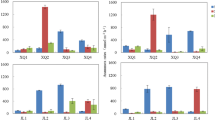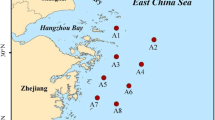Abstract
Anaerobic ammonium oxidation (anammox) pathway is sensitive to organic matter, and its recovery requires reliable evidence regarding the dominance of anammox in N-removal. This study showed that the anammox process deteriorated, with N-removal efficiencies rapidly decreasing from 87.2 to 45.7% when reactors were exposed to COD shocks of 1.12, 2.24 and 3.36 g L−1 (COD/N ratio 2, 4 and 6). Comprehensive assessments of water quality, microbial characteristics and isotope analysis were adopted to investigate anammox recovery. Operational performance took 8–20 days to recover; anammox relative abundance recovered after 20 days, based on the results of fluorescence in situ hybridisation and quantitative PCR; and the anammox pathway contributed to 80.0–91.5% of N-loss 40 days after COD shock terminated, based on the results of the isotope labelling experiment. Therefore, a complete recovery required 40 days. The isotope labelling method supplied a reliable reference for recovery assessment of anammox system in real-world applications.





Similar content being viewed by others
References
De Graaff MS, Temmink H, Zeeman G, van Loosdrecht MC, Buisman CJ (2011) Autotrophic nitrogen removal from black water: calcium addition as a requirement for settleability. Water Res 45:63–74
Vo TT, Nguyen TP (2016) Nitrogen removal from old landfill leachate with SNAP technology using biofix as a biomass carrier. J Biosci Bioeng 122:188–195
Jin RC, Yang GF, Yu JJ, Zheng P (2012) The inhibition of the Anammox process: a review. Chem Eng J 197:67–79
He S, Yang W, Qin M, Mao Z, Niu Q, Han M (2018) Performance and microbial community of anammox in presence of micro-molecule carbon source. Chemosphere 205:545–552
Güven D, Dapena A, Kartal B, Schmid MC, Maas B, Pas-schoonen KVD, Sozen S, Mendez R, Op den Camp HJM, Jettern MSM, Strous M, Schmidt I (2005) Propionate oxidation by and methanol inhibition of anaerobic ammonium-oxidizing bacteria. Appl Environ Microbiol 71:1066–1071
Tang CJ, Zheng P, Ding S, Lu HF (2014) Enhanced nitrogen removal from ammonium-rich wastewater containing high organic contents by coupling with novel high-rate anammox granules addition. Chem Eng J 240:454–461
Strous M, Pelletier E, Mangenot S, Rattei T, Lehner A, Taylor MW (2006) Deciphering the evolution and metabolism of an anammox bacterium from a community genome. Nature 440:790–794
Kindaichi T, Tsushima I, Ogasawara Y, Shimokawa M, Ozaki N, Satoh H, Okabe S (2007) In situ activity and spatial organization of anaerobic ammonium-oxidizing (anammox) bacteria in biofilms. Appl Environ Microbiol 73:4931–4939
Chamchoi N, Nitisoravut S, Schmidt JE (2008) Inactivation of anammox communities under concurrent operation of anaerobic ammonium oxidation (anammox) and denitrification. Bioresour Technol 99:3331–3336
Jin RC, Zhang QQ, Yang GF, Xing BS, Ji YX, Chen H (2013) Evaluating the recovery performance of the ANAMMOX process following inhibition by phenol and sulfide. Bioresour Technol 142:162–170
Qin Y, Yan C, Ren J, Wang T, Han B (2017) Effect of glucose on nitrogen removal and microbial community in anammox-denitrification system. Bioresour Technol 244:33–39
Bernet N, BéLine F (2009) Challenges and innovations on biological treatment of livestock effluents. Bioresour Technol 100:5431–5436
Li JW, Li JL, Gao RT, Wang M, Yang L, Wang XL, Zhang L, Peng YZ (2018) A critical review of one-stage anammox processes for treating industrial wastewater: optimization strategies based on key functional microorganisms. Bioresour Technol 265:498–505
Jia L, Guo J, Fang F, Wei H, Guo D (2013) Effect of organic carbon on nitrogen removal and microbial community in the completely autotrophic nitrogen removal process. J. Chongqing Univ 36:96–103
Jenni S, Vlaeminck SE, Morgenroth E, Udert KM (2014) Successful application of nitritation/anammox to wastewater with elevated organic carbon to ammonia ratios. Water Res 49:316–326
Leal CD, Pereira AD, Nunes FT, Ferreira LO, Coelho ACC, Bicalho SK, Conell EFAM, Ribeiro TB, Chernicharo CADL, de Araujo JC (2016) Anammox for nitrogen removal from anaerobically pre-treated municipal wastewater: effect of COD/N ratios on process performance and bacterial community structure. Bioresour Technol 211:257–266
Zhang ZZ, Cheng YF, Liu YY, Zhang Q, Zhu BQ, Jin RC (2019) Deciphering the evolution characteristics of extracellular microbial products from autotrophic and mixotrophic anammox consortia in response to nitrogen loading variations. Environ Int 124:501–510
Ruscalleda M, Puig S, Mora X, Lopez H, Ganigue R, Balaguer MD, Colprim J (2010) The effect of urban landfill leachate characteristics on the coexistence of anammox bacteria and heterotrophic denitrifiers. Water Sci Technol 61:1065–1071
Ma Y, Yuan D, Mu B, Zhou J, Zhang X (2018) Reactor performance, biofilm property and microbial community of anaerobic ammonia-oxidizing bacteria under long-term exposure to elevated Cu (II). Int. Biodeter Biodeg 129:156–162
Wang Y, Wang Y, Wei Y, Chen M (2015) In-situ restoring nitrogen removal for the combined partial nitritation-anammox process deteriorated by nitrate build-up. Biochem Eng J 98:127–136
Wang XJ, Yang RL, Guo Y, Zhang ZJ, Kao CM, Chen SH (2019) Investigation of COD and COD/N ratio for the dominance of anammox pathway for nitrogen removal via isotope labelling technique and the relevant bacteria. J. Hazard. Mater 366:606–614
Wang S, Peng Y, Ma B, Wang S, Zhu G (2015) Anaerobic ammonium oxidation in traditional municipal wastewater treatment plants with low-strength ammonium loading: widespread but overlooked. Water Res 84:66–75
Ye L, Zhu GB, Lun ZC, Wang ZX, Wang SY, Feng XJ, Yin CQ (2011) Determination of activity and contribution of anammox bacteria to N2 production by molecular biology and isotope analyses. Acta Sci Circum 31:1206–1211
Shen LD, Wu HS, Gao ZQ, Cheng HX, Li J, Liu X, Ren QQ (2016) Distribution and activity of anaerobic ammonium-oxidising bacteria in natural freshwater wetland soils. Appl Microbiol Biot 100:3291–3300
Dapena-Mora A, Hulle SWV, Campos JL, Méndez R, Vanrolleghem PA, Jetten M (2004) Enrichment of anammox biomass from municipal activated sludge: experimental and modelling results. J Chem Technol Biotech 79:1421–1428
Yang W, He SL, Han M, Wang BB, Niu QG, Xu YJ, Chen Y, Wang HB (2018) Nitrogen removal performance and microbial community structure in the start-up and substrate inhibition stages of an anammox reactor. J Biosci Bioeng 126:88–95
The State Environmental Protection Administration of China (SEPA) (2002) Monitoring and analytical methods of water and wastewater, 4th edn. China Environmental Science Press, Beijing
Wen X, Gong B, Zhou J, He Q, Qing X (2017) Efficient simultaneous partial nitrification, anammox and denitrification (SNAD) system equipped with a real-time dissolved oxygen (DO) intelligent control system and microbial community shifts of different substrate concentrations. Water Res 119:201–211
Chu ZR, Wang K, Li XK, Zhu MT, Yang L, Zhang J (2015) Microbial characterization of aggregates within a one-stage nitritation–anammox system using high-throughput amplicon sequencing. Chem Eng J 262:41–48
Schloss PD, Gevers D, Westcott SL (2011) Reducing the effects of PCR amplification and sequencing artifacts on 16s rRNA-based studies. PLoS ONE 6:e27310
Zhang XJ, Zhang HZ, Ye CM, Wei MB, Du JJ (2015) Effect of COD/N ratio on nitrogen removal and microbial communities of canon process in membrane bioreactors. Bioresour Technol 189:302–308
Ni SQ, Ni JY, Hu DL, Sung S (2012) Effect of organic matter on the performance of granular anammox process. Bioresour Technol 110:701–705
Connan R, Dabert P, Khalil H, Bridoux G, Béline F, Magrí A (2016) Batch enrichment of anammox bacteria and study of the underlying microbial community dynamics. Chem Eng J 297:217–228
Shu D, He Y, Yue H, Zhu L, Wang Q (2015) Metagenomic insights into the effects of volatile fatty acids on microbial community structures and functional genes in organotrophic anammox process. Bioresour Technol 196:621–633
Qiang K, Xiao H, Yu F, Miao MS, Qian W, Du YD, Xu F (2017) Pollutant removal and microorganism evolution of activated sludge under ofloxacin selection pressure. Bioresour Technol 241:849–856
Wang Y, Chen J, Zhou S, Wang X, Chen Y, Lin X, Yan Y, Ma X, Wu M, Han H (2017) 16s rRNA gene high-throughput sequencing reveals shift in nitrogen conversion related microorganisms in a CANON system in response to salt stress. Chem Eng J 317:512–521
Speth DR, Zandt MHI, Guerrerocruz S, Dutilh BE, Jetten MSM (2016) Genome-based microbial ecology of anammox granules in a full-scale wastewater treatment system. Nat Commun 7:11172
Wang Z, Zhang XX, Huang K, Miao Y, Shi P, Liu B (2013) Metagenomic profiling of antibiotic resistance genes and mobile genetic elements in a tannery wastewater treatment plant. PLoS ONE 8:e76079
Chen C, Sun F, Zhang H, Wang J, Shen Y, Liang X (2016) Evaluation of COD effect on anammox process and microbial communities in the anaerobic baffled reactor (ABR). Bioresource Technol 216:571–578
Allison SD, Martiny JBH (2008) Resistance, resilience, and redundancy in microbial communities. PNAS 105:11512–11519
Zhang B, Xu XY, Zhu L (2017) Structure and function of the microbial consortia of activated sludge in typical municipal wastewater treatment plants in winter. Sci Rep 7:17930
Tian Z, Zhang J, Song Y (2015) Several key factors influencing nitrogen removal performance of anammox process in a bio-filter at ambient temperature. Environ Earth Sci 73(9):5019–5026
Acknowledgements
This research was financially supported by the Chinese-Japanese Research Cooperative Program (Grant No. 2016YFE0118000), the National Natural Science Foundation of China (Grant No. 51208491) and the Frontier Research Projects of IUE-CAS (Grant No. IUEMS201404).
Author information
Authors and Affiliations
Corresponding authors
Ethics declarations
Conflict of interest
The authors declare that they have no competing interest.
Additional information
Publisher's Note
Springer Nature remains neutral with regard to jurisdictional claims in published maps and institutional affiliations.
Electronic supplementary material
Below is the link to the electronic supplementary material.
Rights and permissions
About this article
Cite this article
Yang, R., Wang, X., Guo, Y. et al. Evaluation of anammox pathway recovery after high COD loading using water quality, molecular biology and isotope labelling analysis. Bioprocess Biosyst Eng 43, 625–636 (2020). https://doi.org/10.1007/s00449-019-02260-0
Received:
Accepted:
Published:
Issue Date:
DOI: https://doi.org/10.1007/s00449-019-02260-0




